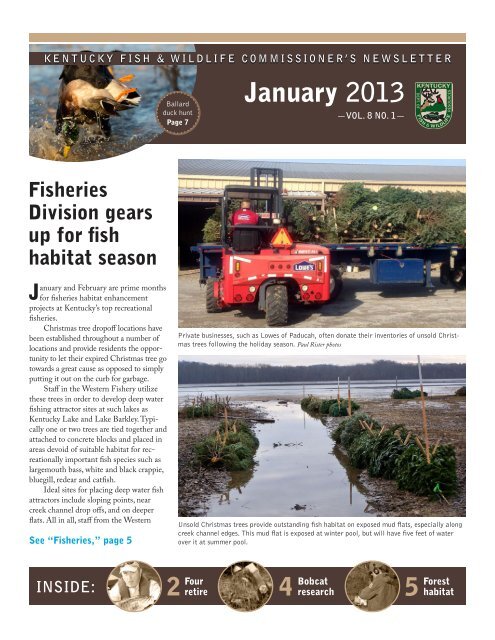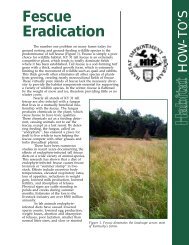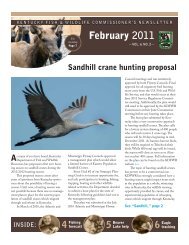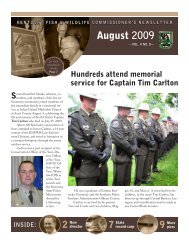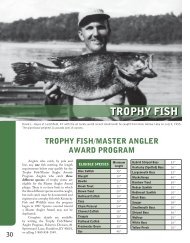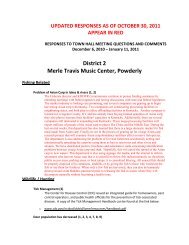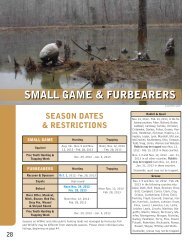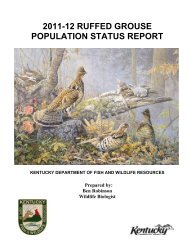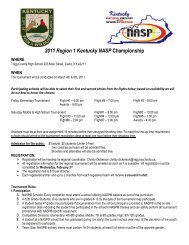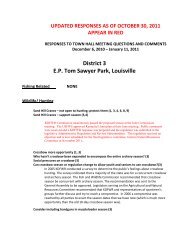January 2013 Newsletter - Kentucky Department of Fish and Wildlife ...
January 2013 Newsletter - Kentucky Department of Fish and Wildlife ...
January 2013 Newsletter - Kentucky Department of Fish and Wildlife ...
Create successful ePaper yourself
Turn your PDF publications into a flip-book with our unique Google optimized e-Paper software.
KENTUCKY FISH & WILDLIFE COMMISSIONER’S NEWSLETTER<br />
Ballard<br />
duck hunt<br />
Page 7<br />
<strong>January</strong> <strong>2013</strong><br />
—VOL. 8 NO. 1—<br />
<strong>Fish</strong>eries<br />
Division gears<br />
up for fish<br />
habitat season<br />
<strong>January</strong> <strong>and</strong> February are prime months<br />
for fisheries habitat enhancement<br />
projects at <strong>Kentucky</strong>’s top recreational<br />
fisheries.<br />
Christmas tree drop<strong>of</strong>f locations have<br />
been established throughout a number <strong>of</strong><br />
locations <strong>and</strong> provide residents the opportunity<br />
to let their expired Christmas tree go<br />
towards a great cause as opposed to simply<br />
putting it out on the curb for garbage.<br />
Staff in the Western <strong>Fish</strong>ery utilize<br />
these trees in order to develop deep water<br />
fishing attractor sites at such lakes as<br />
<strong>Kentucky</strong> Lake <strong>and</strong> Lake Barkley. Typically<br />
one or two trees are tied together <strong>and</strong><br />
attached to concrete blocks <strong>and</strong> placed in<br />
areas devoid <strong>of</strong> suitable habitat for recreationally<br />
important fish species such as<br />
largemouth bass, white <strong>and</strong> black crappie,<br />
bluegill, redear <strong>and</strong> catfish.<br />
Ideal sites for placing deep water fish<br />
attractors include sloping points, near<br />
creek channel drop <strong>of</strong>fs, <strong>and</strong> on deeper<br />
flats. All in all, staff from the Western<br />
See “<strong>Fish</strong>eries,” page 5<br />
Private businesses, such as Lowes <strong>of</strong> Paducah, <strong>of</strong>ten donate their inventories <strong>of</strong> unsold Christmas<br />
trees following the holiday season. Paul Rister photos<br />
Unsold Christmas trees provide outst<strong>and</strong>ing fish habitat on exposed mud flats, especially along<br />
creek channel edges. This mud flat is exposed at winter pool, but will have five feet <strong>of</strong> water<br />
over it at summer pool.<br />
INSIDE:<br />
Four<br />
2 retire<br />
Bobcat<br />
4 research<br />
Forest<br />
5 habitat
2<br />
KENTUCKY FISH & WILDLIFE COMMISSIONER’S NEWSLETTER<br />
WE GET MAIL<br />
Letters to the<br />
Commissioner’s Office<br />
The following note came addressed to<br />
Commissioner Gassett from Eric Hardin<br />
<strong>of</strong> Lebanon, KY. Mr. Hardin wrote, “I<br />
wanted to thank you for all the good work<br />
the <strong>Department</strong> does. Our fishing <strong>and</strong><br />
hunting keep getting better <strong>and</strong> better. My<br />
son <strong>and</strong> I just finished an amazing bow<br />
season! Thanks especially for keeping the<br />
public l<strong>and</strong> hunter in mind.”<br />
This note came to Director Karen<br />
Waldrop from Greta Steverson. Ms.<br />
Steverson wrote, “I wanted to take this opportunity<br />
to express my sincere thanks for<br />
the award I received December 6th as the<br />
NRCS Area 3 Conservationist <strong>of</strong> the Year.<br />
I am very honored <strong>and</strong> humbled to have<br />
been nominated. My role as a conservationist<br />
is made much easier by the support<br />
<strong>and</strong> assistance I receive from your wonderful<br />
staff at KDFW. I would be remiss if<br />
I didn’t let you know that you have some<br />
absolutely great people in your department<br />
who are a joy to work with! Throughout<br />
my career with NRCS, I have had the<br />
pleasure to work with Chris Grasch, Clay<br />
Smitson, Chris Garl<strong>and</strong>, Derek Beard,<br />
Danny Hughes <strong>and</strong> Zak Danks. These<br />
guys are the tops <strong>of</strong> the top in what they<br />
do <strong>and</strong> their assistance to me has been<br />
invaluable! I look forward to continuing<br />
my partnership with KDFW <strong>and</strong> doing<br />
more good things with wildlife conservation.<br />
Thanks again.”<br />
We received the following note from<br />
Jacob Cundiff in Magnolia, KY. He wrote,<br />
“THANK YOU! Dear GreenWing helpers<br />
<strong>and</strong> providers, I had a great time. The<br />
gifts (door prizes) at the end were amazing.<br />
It was just like Christmas. I hope I get<br />
to go next year. P.S. My Gr<strong>and</strong>pa had a<br />
great time, too.”<br />
Members <strong>of</strong> the <strong>Fish</strong> <strong>and</strong> <strong>Wildlife</strong> Commission presented Bobby Reese with a retirement<br />
plaque at their December meeting in thanks for the many commission functions he helped with<br />
throughout his career.<br />
John Aldridge pauses with some <strong>of</strong> his fellow workers. From left are Patrick Roberts, Joann<br />
Mattox, Aldridge, Pete Elliott, Chris Sutherl<strong>and</strong> <strong>and</strong> Todd Murphy.<br />
Reese, Aldridge, Bucy, Grundy retire<br />
The <strong>Department</strong> sends best wishes to<br />
two longtime Headquarters employees<br />
who retired at the end <strong>of</strong> December.<br />
Bobby Reese <strong>and</strong> John Aldridge <strong>of</strong><br />
Administrative Services Division combined<br />
for nearly three decades <strong>of</strong> service<br />
to our agency, <strong>and</strong> each helped in so many<br />
ways that many say that the full impact<br />
<strong>of</strong> their leaving might not be known for a<br />
long time.<br />
Reese, after a long farming career,<br />
started with the department in June<br />
1989 as a janitor. He quickly moved up<br />
to Clerk, later to Maintenance Worker,<br />
<strong>and</strong> Maintenance Supervisor. He retired<br />
as Maintenance Superintendent. He was<br />
a key part <strong>of</strong> multiple department special<br />
functions throughout his entire career, <strong>and</strong><br />
his assistance will be missed. He plans to<br />
stay busy on his Shelby County farm. We<br />
wish Bobby well.<br />
Aldridge began his <strong>Department</strong> career<br />
in 1987 as a seasonal watchman after<br />
30 years working in the private sector. He<br />
See “Retire,” page 3
JANUARY <strong>2013</strong><br />
3<br />
Kenneth Bucy<br />
Jim Grundy<br />
“Retire,” continued<br />
served the department as Security Guard,<br />
Facility Security Officer, <strong>Fish</strong> <strong>and</strong> <strong>Wildlife</strong><br />
Technician II <strong>and</strong> Maintenance Superintendent<br />
during his 25 years <strong>and</strong> eight<br />
months. We wish John well in his welldeserved<br />
retirement.<br />
The <strong>Fish</strong>eries Division also announces<br />
the December 31 retirement <strong>of</strong> long-time<br />
<strong>Fish</strong> <strong>and</strong> <strong>Wildlife</strong> Technician Kenneth<br />
Bucy.<br />
Bucy started his career with the<br />
<strong>Department</strong> as a creel clerk on <strong>Kentucky</strong><br />
Lake in the spring <strong>of</strong> 1990, following his<br />
retirement from General Tire in Mayfield,<br />
<strong>Kentucky</strong>. He did such an outst<strong>and</strong>ing<br />
job that he was immediately hired as a<br />
full time <strong>Fish</strong> <strong>and</strong> <strong>Wildlife</strong> Technician<br />
upon the completion <strong>of</strong> the creel survey.<br />
Over the years, his expertise has helped to<br />
conserve <strong>and</strong> manage the fisheries <strong>of</strong> the<br />
14 western counties (which collectively<br />
make up the Western <strong>Fish</strong>ery District)<br />
<strong>of</strong> <strong>Kentucky</strong>. He helped collect countless<br />
numbers <strong>and</strong> species <strong>of</strong> fish using electr<strong>of</strong>ishing,<br />
trap net, gill net, hoop net, trot<br />
line, seine, <strong>and</strong> back pack electr<strong>of</strong>ishing.<br />
Kenneth’s knowledge <strong>of</strong> the fishery<br />
<strong>and</strong> <strong>Kentucky</strong>/Barkley Lakes helped<br />
enhance numerous special projects during<br />
his career, particularly his knowledge <strong>of</strong><br />
crappie <strong>and</strong> catfish species. His input was<br />
regularly sought to help determine ideal<br />
sampling areas <strong>and</strong> techniques. Having<br />
commercial fished for a period in his life,<br />
Kenneth’s underst<strong>and</strong>ing <strong>of</strong> catfish helped<br />
paved the way for many department projects<br />
aimed at sampling <strong>and</strong> collecting data<br />
for this important group <strong>of</strong> fish. Additionally,<br />
throughout his career, Kenneth has assisted<br />
<strong>Fish</strong>eries staff with the creation <strong>and</strong><br />
enhancement <strong>of</strong> countless numbers <strong>of</strong> fish<br />
attractor sites both locally <strong>and</strong> throughout<br />
the state.<br />
Arguably Kenneth’s most valuable<br />
contribution was his ability to fabricate<br />
<strong>and</strong> fix most anything. He is an expert<br />
welder <strong>and</strong> could always be counted on<br />
to ensure that equipment was kept in top<br />
running shape, in addition to enhancing<br />
Pennington promoted<br />
Josh Pennington was promoted to<br />
<strong>Fish</strong>eries Research Biologist at the Peter<br />
W. Pfeiffer <strong>Fish</strong> Hatchery Jan. 1. Josh<br />
has a BS in wildlife management from<br />
Ohio University, <strong>and</strong> has nearly completed<br />
a Masters in Aquaculture at <strong>Kentucky</strong><br />
State University.<br />
Josh started with the <strong>Department</strong> <strong>of</strong><br />
existing equipment.<br />
Kenneth retires having worked in<br />
excess <strong>of</strong> 20 years with the <strong>Department</strong>.<br />
He enjoys deer, turkey, <strong>and</strong> waterfowl<br />
hunting, in addition to being an expert<br />
angler for crappie <strong>and</strong> catfish. We are sure<br />
that retirement will allow Kenneth to<br />
devote more time to his passions, as well<br />
as spending time with his wife, children,<br />
<strong>and</strong> gr<strong>and</strong>children. Kenneth’s service to<br />
the <strong>Department</strong> will without question be<br />
missed.<br />
Jim Grundy, <strong>Fish</strong> <strong>and</strong> <strong>Wildlife</strong><br />
Technician at Green River WMA, retired<br />
from <strong>Fish</strong> <strong>and</strong> <strong>Wildlife</strong> December 31. Jim<br />
worked for the <strong>Department</strong> for 12 years.<br />
He plans to enjoy his retirement raising<br />
cattle <strong>and</strong> tobacco on the family farm in<br />
Lebanon, <strong>Kentucky</strong>.<br />
<strong>Fish</strong> <strong>and</strong> <strong>Wildlife</strong> Resources in 2006 as a<br />
technician at Clay WMA, <strong>and</strong> then took a<br />
full-time technician position at the Pfeiffer<br />
Hatchery. In 2008 he was promoted to<br />
<strong>Fish</strong> Biologist II. Since 2011 he has lived<br />
at the hatchery with his wife Mallory, <strong>and</strong><br />
they now have a one year-old daughter,<br />
Madelyn.
4<br />
KENTUCKY FISH & WILDLIFE COMMISSIONER’S NEWSLETTER<br />
Bobcat research in south-central <strong>Kentucky</strong><br />
By Steven Dobey<br />
Bobcats are easily recognized as one <strong>of</strong><br />
the most elusive wildlife species in<br />
the eastern U.S. Since last year, however,<br />
<strong>Wildlife</strong> Division biologists have been<br />
trapping this wary furbearer in an effort to<br />
learn more about its population demographics<br />
<strong>and</strong> movement patterns.<br />
Historically, bobcats have been a<br />
much sought-after furbearer in the Commonwealth<br />
<strong>and</strong> this trend continues today.<br />
The most recent five-year average indicates<br />
that <strong>Kentucky</strong>’s statewide bobcat harvest<br />
averages 2,096 annually for hunters <strong>and</strong><br />
trappers, with considerable variation in<br />
harvest from year to year.<br />
Of particular interest is the trend<br />
that approximately 25 percent <strong>of</strong> bobcats<br />
harvested by gun since 2007 took place<br />
during a 9-day window when the modern<br />
gun season for deer was open statewide.<br />
Ultimately, concerns for excessive harvest<br />
led to current research efforts to learn<br />
more about this furbearing species that is<br />
so iconic to <strong>Kentucky</strong>.<br />
During the summer <strong>of</strong> 2012, <strong>Wildlife</strong><br />
Division personnel implemented a systematic<br />
survey <strong>of</strong> Green River Lake WMA<br />
(GRLWMA) using remote cameras to<br />
document presence/absence <strong>of</strong> bobcats<br />
<strong>and</strong> identify occupancy patterns. Trapping<br />
efforts began in earnest this past October<br />
with a goal <strong>of</strong> equipping as many cats as<br />
possible with GPS-enabled radio collars.<br />
In doing so, the Furbearer Program will<br />
obtain valuable data concerning habitat<br />
use, movement patterns, <strong>and</strong> survival.<br />
Ultimately, data collected from study<br />
animals will provide valuable insight to the<br />
habitat requirements <strong>of</strong> bobcats <strong>and</strong> factors<br />
that influence survival rates. More so,<br />
these research efforts will greatly assist in<br />
the development <strong>of</strong> future harvest strate-<br />
See “Bobcat,” page 5<br />
GREENWING SUCCESS<br />
Youth hunters participating in the Camp Currie GreenWing waterfowl hunt at the Po Po Hole in Ballard County Saturday, <strong>January</strong> 5, came<br />
away with six ducks <strong>and</strong> an all around great experience. First District conservation <strong>of</strong>ficers Tony Dunker <strong>and</strong> Sgt. Garry D. Clark assisted. Youth<br />
joined by their fathers for the special hunt were Jordyn Hensley, 12; Jacob Kent, 11; <strong>and</strong> Travis Priddle, 11.
JANUARY <strong>2013</strong><br />
5<br />
Improving the mix<br />
Clay WMA Technician Brian Wagoner girdles<br />
a Licking River box elder to create a small<br />
canopy gap for planted oak seedlings.<br />
“Bobcat,” continued<br />
gies as interest in this important furbearing<br />
species continues to grow.<br />
Through mid-<strong>January</strong>, trapping efforts<br />
by project researchers have resulted in<br />
the capture <strong>of</strong> 14 (nine male, five female)<br />
bobcats. Special recognition goes out to<br />
all KDFWR personnel that continue to<br />
provide invaluable contributions to this<br />
project. Those include Furbearer Biologist<br />
Laura Patton, Research Program<br />
Coordinator Danna Baxley, Public L<strong>and</strong>s<br />
Biologist Brian Gray, <strong>and</strong> FW Technician<br />
Casey Hatch.<br />
Trapping efforts will continue<br />
through winter in an attempt to increase<br />
our sample size <strong>of</strong> radiocollared cats on<br />
the study area <strong>of</strong> GRLWMA <strong>and</strong> some<br />
surrounding properties.<br />
Managing wildlife<br />
habitat can be a<br />
bit tricky sometimes.<br />
Managing forest wildlife<br />
habitat can be downright<br />
complicated because<br />
present day forests are a<br />
product <strong>of</strong> their current<br />
environment as well as<br />
decades <strong>and</strong> even centuries<br />
<strong>of</strong> human use.<br />
The Clay <strong>Wildlife</strong><br />
Management Area encompasses<br />
more than 12<br />
miles <strong>of</strong> Licking River<br />
frontage in Nicholas,<br />
Fleming, <strong>and</strong> Bath<br />
Counties. One concern<br />
<strong>of</strong> KDFWR biologists<br />
responsible for managing<br />
this WMA is the<br />
composition, or mix, <strong>of</strong><br />
forest habitat.<br />
This is especially true in many bottoml<strong>and</strong><br />
riparian areas along the river. A<br />
lack <strong>of</strong> hard mast (acorn) production in<br />
many <strong>of</strong> these areas seriously degrades<br />
their overall value for wildlife.<br />
Light seeded trees such as sycamore<br />
“<strong>Fish</strong>eries,” continued<br />
<strong>Fish</strong>eries District typically refurbishes<br />
approximately 130 units <strong>of</strong> brush annually<br />
at such deep water sites. Newer sites are<br />
developed if the number <strong>of</strong> available trees<br />
is adequate.<br />
In addition to these deep water sites,<br />
staff also utilize trees to develop shallow<br />
water fish attractor <strong>and</strong> spawning sites.<br />
Such areas are <strong>of</strong>ten located along exposed<br />
mud flats at winter pool elevations, that will<br />
provide anywhere from two to five feet <strong>of</strong><br />
water once reservoirs reach their summer<br />
pool elevations in late spring/early summer.<br />
In the Western <strong>Fish</strong>ery District,<br />
<strong>and</strong> box elder now dominate most <strong>of</strong> these<br />
riparian bottoml<strong>and</strong> areas <strong>and</strong> have for<br />
so long that heavy seeded trees such as<br />
swamp white oak, pin oak, <strong>and</strong> bur oak are<br />
now rare or gone.<br />
KDFWR staff are working to<br />
improve wildlife habitat in these Licking<br />
River bottoml<strong>and</strong> riparian areas by<br />
reintroducing prolific acorn producers<br />
back into the mix.<br />
That can be easier said than done,<br />
because the present day, light-seeded trees<br />
such as sycamore <strong>and</strong> box elder are aggressive<br />
growers <strong>and</strong> seed producers. Flood<br />
waters, heavily laden with their light seeds,<br />
add to the problem <strong>of</strong> their dominance.<br />
Our strategy is to punch small holes<br />
in the current riparian forest by girdling<br />
box elder <strong>and</strong> sycamores, <strong>and</strong> planting<br />
vigorous oak seedlings in the canopy gaps.<br />
By working on this forest mix we<br />
hope to someday make these areas once<br />
again the highly productive wildlife areas<br />
they once were.<br />
This is a long-term project that may<br />
require many years <strong>of</strong> effort to rectify, but<br />
any improvement in hard mast production<br />
in these areas will be a major improvement<br />
in wildlife habitat quality.<br />
donated trees are <strong>of</strong>ten provided by private<br />
individuals <strong>and</strong> businesses. Over the last<br />
several years, Home Depot <strong>and</strong> Lowes<br />
(both <strong>of</strong> Paducah) <strong>and</strong> Wal-Mart (Benton)<br />
have graciously donated a large supply<br />
<strong>of</strong> those trees that were unsold during the<br />
holiday season.<br />
Staff also work with local volunteer<br />
groups, such as the Calloway County<br />
High School Bass Club to help create fish<br />
habitat.<br />
A large amount <strong>of</strong> effort goes into<br />
these habitat enhancement projects, all<br />
with the ultimate goal to help increase<br />
angler catch rates <strong>and</strong> provide suitable<br />
spawning habitat for sport fish.
6<br />
KENTUCKY FISH & WILDLIFE COMMISSIONER’S NEWSLETTER<br />
BALLARD MALLARDS<br />
A flock <strong>of</strong> mallards takes <strong>of</strong>f from a flooded area at Ballard <strong>Wildlife</strong> Management<br />
Area earlier this month. The Ballard staff turned on the main pumps that pull<br />
water from the river to flood the WMA’s many moist soil areas which are drawn<br />
down in the summer to stimulate growth <strong>of</strong> natural duck foods. John Brunjes photos
JANUARY <strong>2013</strong><br />
7<br />
DUCK HUNT<br />
The Ballard <strong>Wildlife</strong> Management<br />
Area is usually teaming with ducks this<br />
time <strong>of</strong> year <strong>and</strong> after a recent hunt,<br />
<strong>Wildlife</strong>’s John Brunjes returned with<br />
some enduring photographic memories.


